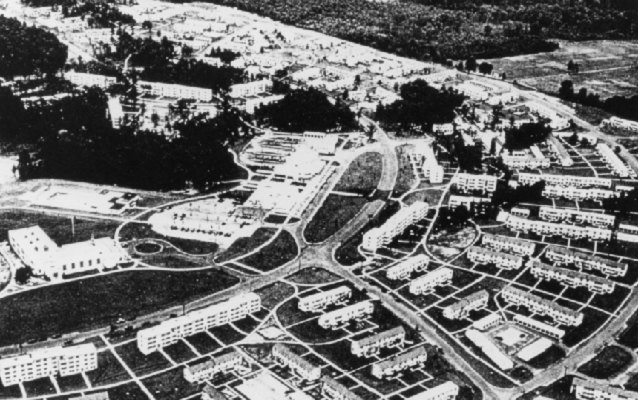Last updated: July 2, 2018
Place
Greenbelt Historic District

In the 1930s, critics attacked the idea of a federally sponsored city protected from over-crowding, sprawling, and haphazard development as “radical and “socialistic.” Detractors believed it would be too government-controlled. Under public scrutiny, Tugwell worked carefully to socially engineer a prosperous community. Before selecting the sites for the “greenbelt towns,” researchers noted specific parameters of healthy communities, including social and economic growth, the presence of wooded areas for parks and recreation, and the availability of low-priced land. The farmland of the Washington suburbs in Prince George's County fit the bill. Those who wished to live in the new city had to furnish references and medical records as part of the vigorous application process, which initially excluded African Americans. New residents called themselves pioneers.
The Maryland State Legislature chartered Greenbelt, the first municipality in the state to have the council-manager form of government, in June 1937. The architecture of Greenbelt clearly reflected a modernist approach, with straightforward housing and more style-conscious public buildings. Many preserved structures exhibit Bauhaus and Art-Deco detailing.
In order to reduce streets and utility lines, city planners followed the land's natural topography to create a crescent-shaped layout, each with rows of concrete-block single-family and multi-family dwellings. All homes featured a garden, and were linked to one another by paved foot paths. At the outbreak of the World War II, the federal government constructed an additional 1,000 frame houses for workers engaged in the national defense effort.
Pedestrian underpasses beneath major roads still connect the housing to a town common, which features the Greenbelt commercial center—one of the oldest planned shopping centers in the country. Planners purposefully located the commercial area off of main roads to deter non-neighborhood business. Opened in 1937, the center offered residents one stop for all of their shopping and service needs, including a grocery store, dry cleaners, barber and beauty shops, bank, post office, and later, an affordable furniture store. This area continues to be a commercial center in 2018. A mother and child statue, sculpted in sandstone by Maryland artisit Lenore Thomas for the U.S. Resettlement Administration in the early 1930s, sits in the middle of the open-air mall courtyard.
Nearby the commerical area, a two-story community building, originally a school and community center, first opened its doors in October 1937. On the weekends, the building hosted religious services and recreational activities. An outdoor recreational area with a swimming pool and athletic facilities was located behind the town common, and a 27-acre man-made lake (built to cover swampland) was just beyond. According to lore, in 1936, President Franklin D. Roosevelt placed the first fish into the lake. In 1952, a cooperative named “Greenbelt Homes Inc.” bought much of the city from the federal government.
Greenbelt’s location along major roads and its proximity to downtown Washington, DC, has placed enormous pressures on the community to expand. Much of the original belt of green has given way to shopping centers, garden apartments, single-family homes, and condominiums. The population of the city has increased exponentially, starting at 3,000 in 1937 and reaching almost 24,000 in 2018 (the city boundaries have expanded as well).
The historic district includes the original dwellings, and discontiguous parcels such as Greenbelt Junior High School, Greenbelt City Cemetery, and Indian Springs Park. Residents continue to participate in the cooperative housing system. The city’s outstanding safety record is in part due to the separation of roads and pedestrian walkways. In the 1960s, two other planned communities in Reston, Virginia and Columbia, Maryland, expanded on the effective elements of Greenbelt. The preserved architecture and setting of the Greenbelt Historic District stands as a testament to the successful New Deal experiment of innovative and socially conscious city planning.
National Historic Landmark Nomination of Greenbelt Historic District.
National Historic Landmarks (NHLs) are historic places that possess exceptional value in commemorating or illustrating the history of the United States. The National Park Service’s National Historic Landmarks Program oversees the designation of such sites. There are just over 2,500 National Historic Landmarks. All NHLs are also listed in the National Register of Historic Places.
